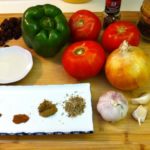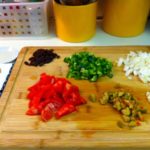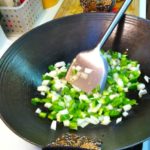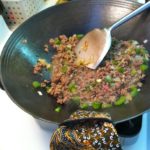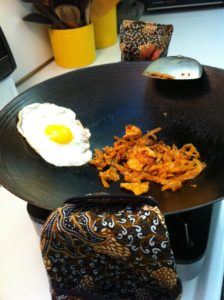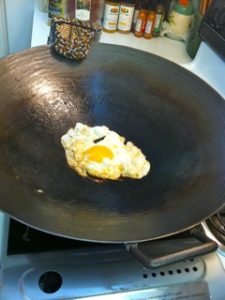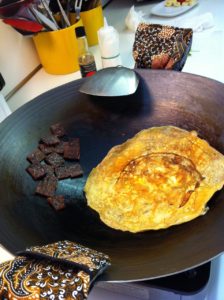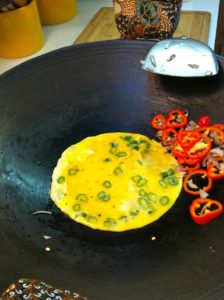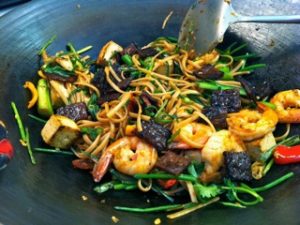I was thrilled to get contacted by Associated Press’ Food Editor, J.M. Hirsch to write an article, “Asian techniques meet Hispanic ingredients”, which got picked up by many news sites around the world including Taiwan and Trinidad! My local newspaper, Miami Herald picked this up and did a huge feature story and included 2 more dishes! It all started on Facebook with a request to find out what spices and ingredients were significant in Hispanic cooking! Whoosh, an avalanche erupted, I love how social media connects people, so join in the conversation.
What a coincidence my Wok Picadillo goes with this month’s theme, Cross Cultural dishes for #LetsLunch. A fusion mashup using my technique to ‘season’ the ground beef like I would a stir fry but keeping the olives and raisins for a Hispanic touch. There’s so many interesting similarities between Asian and Hispanic dishes like Paella and Fried Rice or Peruvian Chifa. I’m constantly encouraging people to use their woks for other styles of cooking or even toasting nuts and spices.

This Cuban Wok Picadillo uses my same cooking process for a stir fry. Many Hispanic students love this approach, you can even see a video of them talking about it here. I learned to use the term “seasoning” instead of “marinading” because I don’t use a ton of liquid to soak my meat like a western marinade, try it you’ll really notice a difference in the texture of your meat!
Do get an rss feed or subscribe to my newsletter in right sidebar because I tend to make revisions to a post after it’s published. I’ll be experimenting a lot more with adapting other styles of cooking in a wok including my mom’s banana fritters!
Wok Baked Tortilla Omelet and Wok Fajitas (posting soon) are 2 more Hispanic dishes I’ve adapted in my wok, enjoy.
I’d love to hear what Hispanic dishes work well you’ve made in your wok?
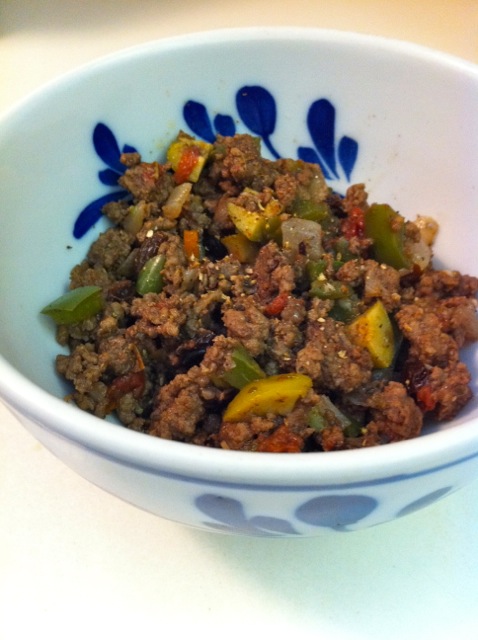
WOK PICADILLO
In a medium bowl, whisk together the tamari, sherry, cornstarch and white pepper. Add the ground beef and mix until thoroughly incorporated. Set aside.
Set your wok over high and let heat for 1 minute. Add 1/2 tablespoon of the oil and heat until it shimmers. Add the onion and both bell peppers. As soon as they hit the wok, immediately stir them around the pan. Cook for 5 minutes, or until the onions and peppers are just barely cooked and still firm and colorful.
Transfer the vegetables to a plate. Use paper towels to dry the wok, then return it to the heat.
When the wok is hot again, add the remaining 1/2 tablespoon of oil and heat until it shimmers. Add the garlic first, then immediately add the ground beef.
Use the back of the spatula to spread the beef across the wok as if frying a wide burger. Let the meat sear on one side until golden brown. This gives your meat a crispy exterior with juicy interior. You can test for doneness by flipping beef in the center of your wok where the heat is the hottest. If it is golden brown, flip all the beef and start breaking it up with your spatula.
Once the beef is just cooked (when you don’t see any red, about 7 minutes), return the onion-pepper mixture to the pan. Add the tomatoes, olives, raisins, cumin, oregano and paprika. Mix well, then reduce heat to medium and fry for 5 minutes. Stir in the lime juice.
Serve spooned over rice and topped with fresh cilantro, mint or parsley.
Nutrition information per serving (values are rounded to the nearest whole number): 340 calories; 160 calories from fat (47 percent of total calories); 17 g fat (5 g saturated; 0.5 g trans fats); 75 mg cholesterol; 19 g carbohydrate; 25 g protein; 3 g fiber; 670 mg sodium.
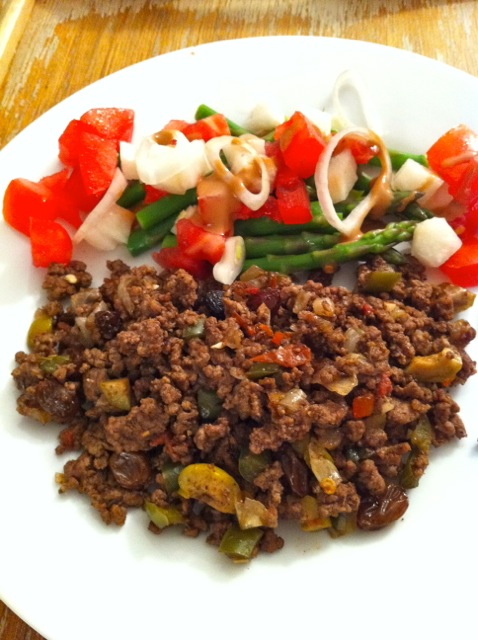
It’s always fun hopping to these blogs to peek at what everyone else cooked up! Plse come back as I update this list.
Emma‘s Kimchi Bulgogi Nachos at Dreaming of Pots And Pans
Grace‘s Taiwanese Fried Chicken at HapaMama
Jill‘s Southern Pimento-Stuffed Knishes at Eating My Words
Joe‘s Grilled KimCheese Sandwich at Joe Yonan
Linda‘s Project Runway Pelau: Rice & Beans Trinidad-Style at Spicebox Travels
Lisa‘s Sunday Night Jewish-Chinese Brisket at Monday Morning Cooking Club
Lucy‘s Coconut Rice Pudding with Mango at A Cook And Her Books
Nancie‘s Chili-Cheese Biscuits with Avocado Butter at Nancie McDermott
Rashda‘s Mango Cobbler at Hot Curries & Cold Beer
Renee‘s Asian-Spiced Quick Pickles at My Kitchen And I
Steff‘s Chicken Fried Steak at The Kitchen Trials
Vivian‘s Funky Fusion Linguini at Vivian Pei
